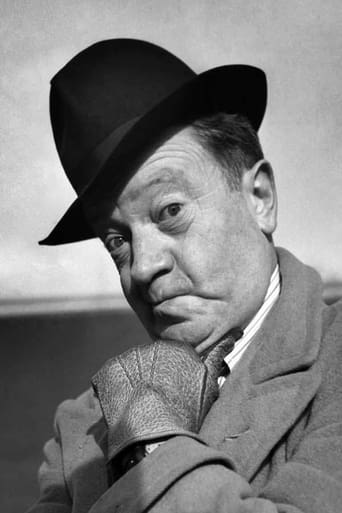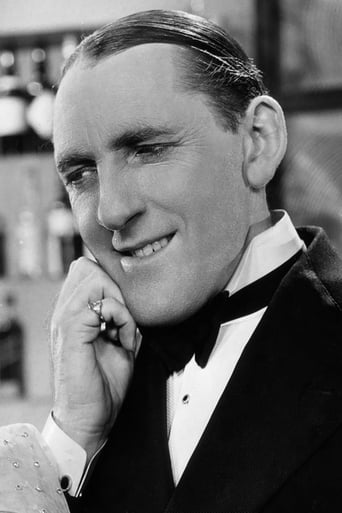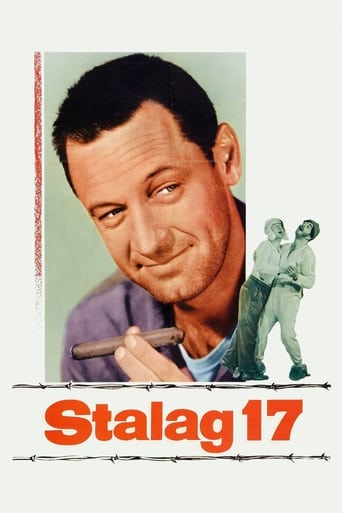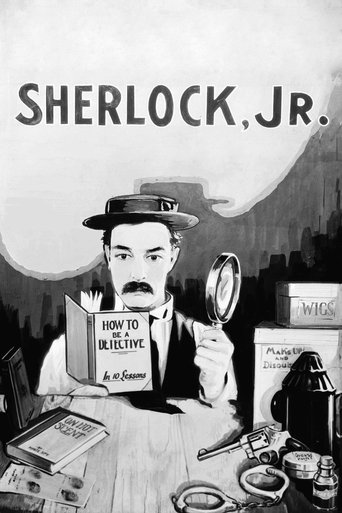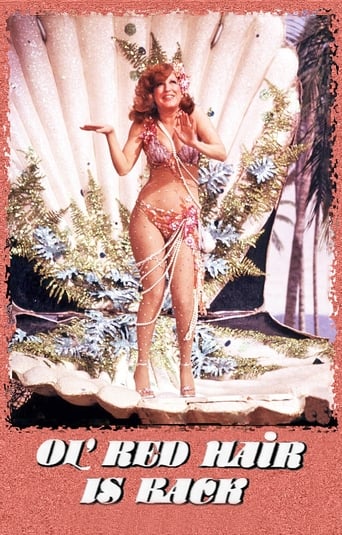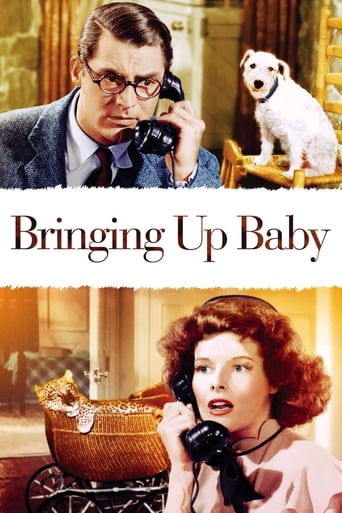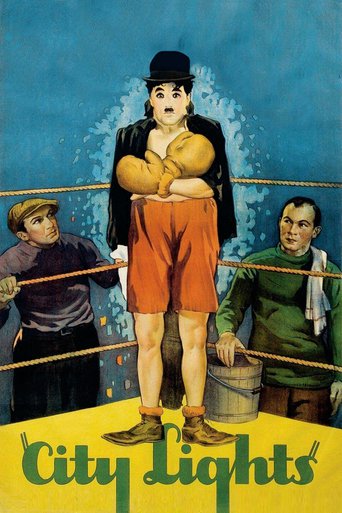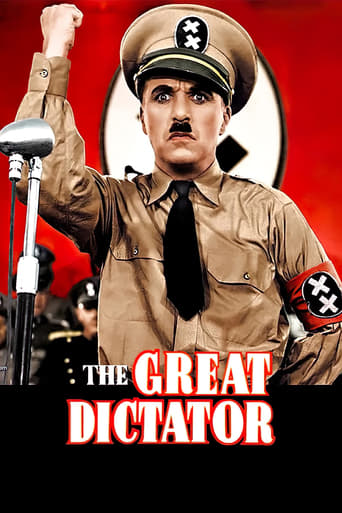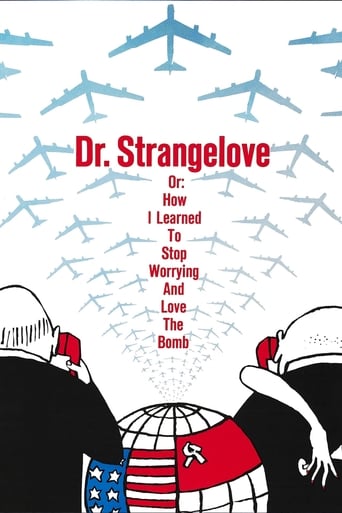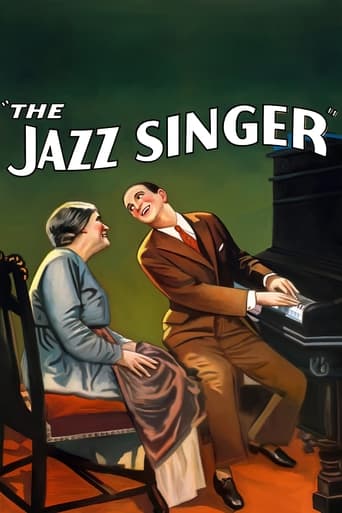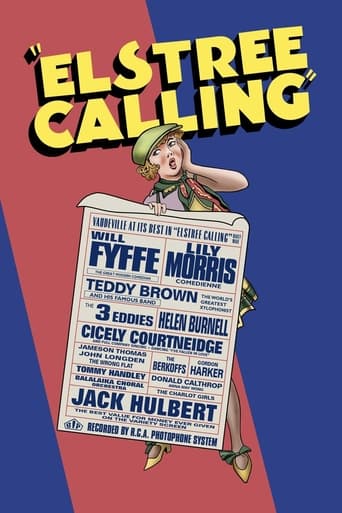
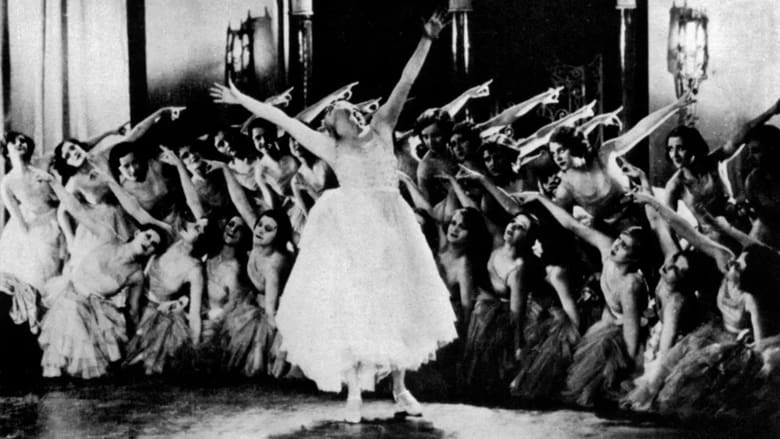
Elstree Calling (1930)
A series of 19 musical and comedy "vaudeville" sketches presented in the form of a live television broadcast hosted by Tommy Handley (as himself).
Watch Trailer
Cast
Similar titles
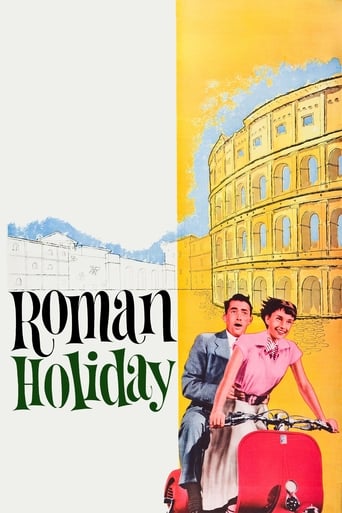

Reviews
Thanks for the memories!
Absolutely Fantastic
Let me be very fair here, this is not the best movie in my opinion. But, this movie is fun, it has purpose and is very enjoyable to watch.
One of the worst ways to make a cult movie is to set out to make a cult movie.
Released in 1930, Elstree Calling was directed by Andre Charlot, Jack Hulbert, Paul Murray, and Alfred Hitchcock. Luckily, too many cooks did not spoil the broth in this case but created a marvelous musical and comedic soufflé. The film is a series of vaudeville-type skits and sketches. Tommy Handley hosts the show. "Think, and having thunk, think again," Handley humorously advises the audience. The sections vary in quality but none are poor. Among the best: Teddy Brown whistling while playing the xylophone; lovely, blonde, and ethereal Helen Burnell in a sparkling sequined gown singing; a sprightly Russian-style song and dance number; Cicely Courtnedge singing an entrancing rendition of I'm Falling In Love; and Jack Hulbert and Helen Burnell in a dynamic duet. One brief sketch is darkly humorous as a man appears to enter a home, shoot the man and woman he "catches" kissing, only to realize, "I'm in the wrong flat!" In one section, bagpipes play while a Scotsman in a kilt sings about how "happiness costs such a lot." It is wonderfully sung but some viewers may be offended by the way it plays on the stereotype of the Scots as stingy.Far more viewers are apt to be offended by the sketches done by "The Three Eddies." The tap dancers are in blackface with white lips, white bowler hats, and white-rimmed round eyeglasses. Their tap dancing is wonderfully skilled but one does not have to be a stickler for "political correctness" to be disturbed by the racist stereotyping in their act. A better note is struck in a skit in which Elstree Calling appears to play with racial (not necessarily racist expectations). In an odd take on The Taming of the Shrew, Anna Mae Wong is the clearly Asian daughter of a white man. Beautiful Wong appears as Katherine in a shiny and revealing outfit. Instead of being "tamed," this "shrew" gets her revenge by throwing cream pies in the faces of all the men around her – including Shakespeare himself!Like many works from past time periods, Elstree Calling sometimes strikes an "off" chord with contemporary audiences. Nevertheless, it is a fast-paced and fun series. One hour and twenty-six minutes long, it never drags but is a very entertaining potpourri of performances.
In producing this brand-new singing, dancing, all-talkie film, British International Pictures inadvertently contrived to preserve a cross-section of the contemporary London stage scene from the West End to the music halls. Sit back in your seat, enjoy the entertainment beamed directly to your home (I had no idea that television existed in the popular perception long before the BBC), and let yourself be carried away back to the days of 1930, flitting from venue to venue to experience a night out in the London of the era. Some of the acts are to one taste, some to another, but you've paid for the programme as a whole so applaud and wait to see what's coming next.My personal favourite would be the live-wire tapping and jazzy tunes of the Three Eddies' blackface act (especially the skeleton dance!), but while overall I was interested in this revue chiefly for the music -- it features unknown (at least to me) tunes by Vivian Ellis and Ivor Novello, for example -- there's a good deal else that's worth enjoying, and a few tantalising glimpses 'backstage' at the Elstree studios as well."Elstree Calling" was edited on the cheap and rushed out in ten days for a hasty release to recoup the cost of production, and it shows. Few of the five or six camera angles filmed on every shot actually got used, for instance, and a number of bizarre choices seem to have been made, such as choosing to show a dance sequence via a camera focused too high and showing a vast expanse of curtain above the performers' heads but cutting off their actual feet -- or a shot that shows the performers disappearing off the left-hand side of the frame while focusing on the empty set centre-stage. Did anybody even take the trouble to screen these clips before attaching them together? (Director Adrian Brunel, who had left detailed directions for the compilation of his footage only for them to be totally ignored, complained in his autobiography "How could the Hulbert-Courtneidge numbers be slung together like that without looking like casual newsreel photographing?") I was also a bit puzzled by the smoke that appears to be pouring out of the top of the jaw-droppingly gigantic image of 'Little' Teddy Brown in the background of his first musical interlude -- presumably a side-effect of the stage lighting? But it isn't just the editing: certainly in the chorus sequences, the choreography tends to suffer from being cramped onto a film set, while no-one seems to yet have worked out how to avoid having a long line of girls strung out across the middle of a square-format screen. (See, e.g. the chorus sequences in British-Gaumont's "First a Girl" for more sophisticated treatment later in the Thirties.)Still, I found this glimpse onto the theatre world of the era thoroughly enjoyable: it was particularly interesting after having screened the shorts in the silent "On With the Dance" series of only a few years only, since the styles are very similar but obviously this time with music. Just don't expect cinema: theatre is what is advertised, and theatre is what you will get -- though there is a brief homage to the antics of Douglas Fairbanks in the burlesque "Taming of the Shrew" that closes the act!
This is interesting as a period piece. It is also of interest to Hitchcock fans.Rather like the better-known American film King of Jazz, it is a collection of sketches albeit from the British music halls. Alas, this film is not nearly so good.Sadly the music hall acts do not work so well on film. Will Fyffe, composer of "I Belong to Glasgow" in particular dies the death of a dog in a ditch. There is a little Russian folk instruments orchestra who are uncredited. They probably only cost the studio ten pounds for the lot, and they may have been the same musicians who accompanied the great bass singer Fyodor Shalyapin on some of his best known records. To me they are the one act who come across well in this film. (Unlike Will Fyffe, balalaikas and domras will hold their own anywhere.) Sadly we may never know their names.I doubt if the film makers were aware that what they were producing was a time capsule.
I've probably seen this one over a dozen times now and I still love it, but mainly from the standpoint of the music. You have to forget you are a film buff (you are, aren't you?) and think of it as a collection of pop videos from 1930. And the pop ranges from the sublime to the ridiculous: My Heart Is Saying, in colour (?) nicely sung by Helen Burnell but danced atrociously, to Only A Working Man in b&w by the incomparable Lily Morris. Praise the Lord this film was made if only for her two turns, also the Will Fyffe bits and the Cicely Courtneidge end song, I'm Falling In Love. How that one passed the censor at the time I'll never know ... I suppose no one told him!Helen Burnell must have been the dancing inspiration for Jessie Matthews, or did all Show People dance like hippos pretending to be trees in the 20's? I've always loved the work of Jack Hulbert, mainly for his innocent British enthusiasm (and songs), but I'm afraid that he looked like a manic bus conductor in his one dance scene. Rotund Teddy Brown was marvellous to listen to - until he started telling jokes; The 3 Eddies - ah! Can you just imagine them walking on stage and launching into their high powered act nowadays? Horrified silence would follow, but how times and tastes have changed. The song Ladies Maids Always In The Know sung and danced to by the Charlot Girls would likewise be incomprehensible to nearly everyone too.The glue that 'holds' all this and more together is supplied by Gordon Harker trying to get a picture of it all on his TV and Tommy Handley as TV linkman, with some surprisingly flat gags for a change. A running gag is supplied by Donald Calthrop attempting to perform Shakespeare; Anna May Wong puts him in his place - have you ever seen 'Taming of the shrew' with a massive custard pie fight or with a circling riderless motorcycle being whipped?If you're going to watch this for the Hitchcock bits and are unmusical you won't like it, but if you can open your ears and hearts to these fine personalities from a bygone age then like me you may get something like innocent merriment from Elstree Calling.
